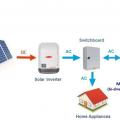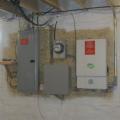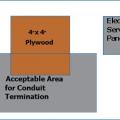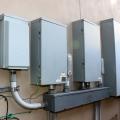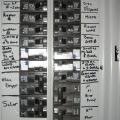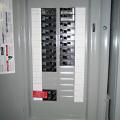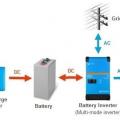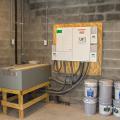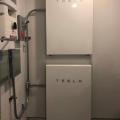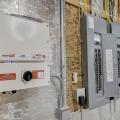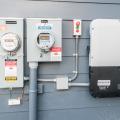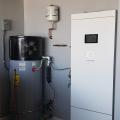Showing results 1 - 22 of 22
A roof-mounted solar electric system can be sized to produce enough electricity to power the home and an electric car.
Basic layout diagram of an AC-coupled solar battery system with a Grid-tied (hybrid) setup
Durable Energy Builders installed a natural gas generator integrated with the solar electric system via a “smart panel” so that household utilities automatically switch to the generator during power outages in the disaster-resilient home.
Example of a basic layout for a DC-coupled off-grid solar battery system using a MPPT solar charge controller
Lithium-ion batteries charged by the solar photovoltaic panels provide 200 amperes of standby electricity to critical circuits in case of power failure due to severe weather conditions.
Right - The electronics for this home’s smart home system, including a Wi-Fi router, and controls for lighting, HVAC, security, energy production and tracking are housed together with the electrical panel and HVAC equipment in the home’s utility room.
Right - These inverters convert the power from the home’s 6.8-kW of photovoltaic panels from DC to AC for connection to the grid; the inverters can also be connected to batteries for backup power storage.
Right - This home was made PV ready with the installation of conduit and a dedicated electrical outlet for wiring from the roof to the circuit breaker box on the first floor.
Right – Batteries can extend the hours of power the home’s PV panels can provide.
Right – Blocking is installed next to the electrical panel for future mounting of the PV inverters.
Right – Space was provided next to the electric meter for home’s solar and home energy management tracking electronics.
Right – The builder provided adequate wall space for the solar inverter next to the home’s electric panels.
Right – The PV system inverters and battery take up minimal space in the garage.
Right – The solar system production is tracked next to the home’s electrical meter.
Right – This home solar system includes batteries that provide power during peak evening hours.
Solar electric panels provide electricity for the home and an electric car charging station.
Wall space is provided next to the electrical panel in the garage for the home’s photovoltaics system.

